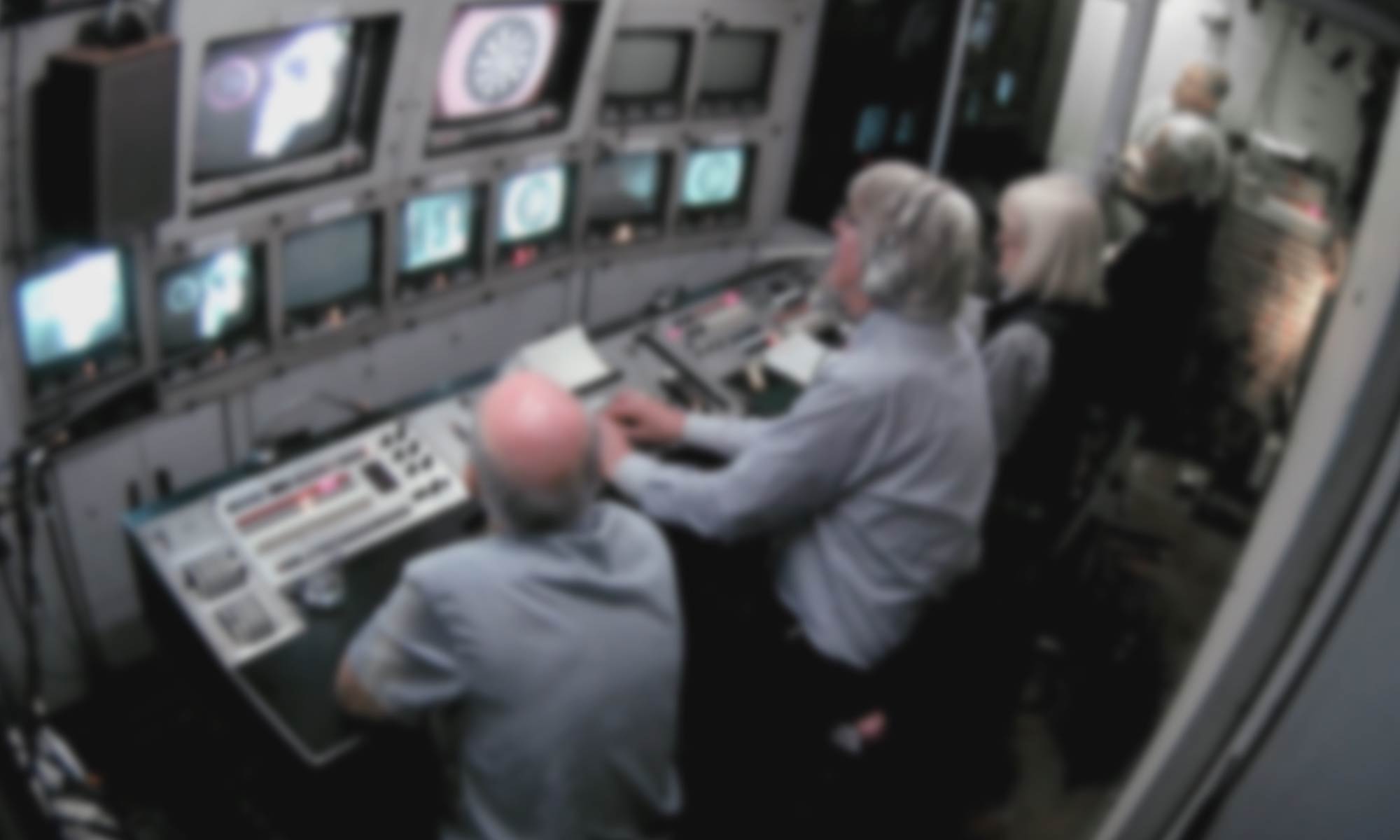Previous blog posts by my Adapt colleague, Professor James Bennett, on our social media research project have focused on ‘Social Media in the Television Workplace’ and social media’s impact on the production of live TV. This post shifts our focus from The Voice, as a ‘shiny floor show’ with social production by a discrete digital unit, to draw on our subsequent ethnographic observations of Channel 4’s Sunday Brunch gallery team, 1)The observation was undertaken by Dr Niki Strange on Sunday 13 November 2016 and in particular the modus operandi of their Digital Content Manager. Her role and responsibilities, and the attendant tools and technologies deployed in their service, evidence various adaptations to live television production. As I set out below, this work is increasing integrated into the production processes, timelines and expectations of live TV, but nevertheless somehow remains in a liminal space: both within and beyond television’s previous production boundaries.
Channel 4’s Sunday Brunch is a magazine and cooking show that goes out live between 09.30-12.30 on Sunday mornings on Channel 4 and has been running since 2012. Hosted by Tim Lovejoy and Simon Rimmer it features guest interviews, cookery demonstrations, food and drink features and music performances and video promos.
In terms of its digital presence, there’s a website, serving as a repository for the weekly recipes, previous shows on-demand and the weekly Spotify playlist; accounts on Twitter (@SundayBrunchC4, 313,000 followers), Instagram (42,800 followers), Facebook (114,888 likes). 2)Statistics as of 8th February 2018 It is considered to have one of the most successful social media brands of all Channel 4’s shows. 3)Source – Sunday Brunch Executive Producer, i/v 32, 2016, Adapt Social Media Project In what follows I map those social media activities into three, overlapping, modes: format and related content derivation; promotion; and audience engagement.
Format and related content derivation
During an interview that pre-dates the ethnographic work, the show’s Executive Producer 4)As above described how the production team uses social media to both solicit content for the formatted segments of live show (e.g. call outs for photos, videos along a weekly theme) and as a source of content in and of itself (often tweets, photographs, videos posted on the above platforms by viewers reacting to the show’s on-air content, which could then be integrated into the live show ‘on the fly’.) She spoke of the innovative speed and scale with which this process of viewer content solicitation – itself an established format convention of TV magazine shows – now takes place, due to the proliferation of smart phones and social media platforms and applications and their increasing integration into TV production’s technical array.
I witnessed this in practice as Sunday Brunch’s Digital Content Manager 5)i/v 37, 2016 juggled various devices, social media accounts and aggregation apps, to content manage both pre-scripted and reactive items. Guests, cookery demos, music performances and unexpected or amusing moments were captured by her sprinting from the gallery to the studio to grab shots on her own smart phone, which were then instantly captioned and uploaded to Twitter, Instagram or Facebook using this or another device. Alongside this her role involved the constant surveillance of the show’s numerous social media timelines for viewer responses to format calls for materials (mainly photos) and also unsolicited reactions to the show which could nonetheless be responded to with a reply, retweet or, perhaps most prized of all, inclusion in the live show. Any ‘influencer’ interest – such as a viewing celebrity, or one of the guests, referencing the show on social – was re-tweeted to extend the show’s reach to that person’s own network of social followers.
Promotion
This connects to the second goal of the show’s use of social media – that of promotion. In our interview the Executive Producer spoke of how ‘the ultimate drive is to grow awareness, get re-tweets and new followers and build the show’s brand’ and that social media is considered a vehicle for amplifying the chatty, irreverent tone of voice of the show both during and beyond live transmission. This could be by replying or re-tweeting viewers’ tweets, responding to questions posed, or by commenting on broader pop culture and topical events in the show’s ‘voice’ to maintain a presence in social media timelines outside of TX. In the latter case, this would be at the discretion of the Executive Producer and Digital Content Manager, using their personal devices in their domestic spaces and/or on the move: thus extending the times and spaces of TV production’s workplace.
This promotional aspect to the show’s use of social media was exemplified by the Digital Content Manager’s tweets to build anticipation and awareness among its social followers for the show’s tx at 9.30 with tweets from 7am ‘to signal we’re awake’ 6)i/v 37, 2016 (see fig 1.) and to announce the show’s liveness (as well as intention to mine ‘the conversation’ on its social feed for possible content therein (see fig 2.))
fig 1
fig 2
Audience engagement
Finally, and leading on from the two aspects of content solicitation and promotion/brand extension above, the show’s Executive Producer spoke of social media in terms of highly prized audience interaction and engagement. As well as being a means to build viewer loyalty and a sense of intimacy with the show, she talks of this as a source of professional reward and pride, with social media offering members of production teams access to near instantaneous (though clearly partial) feedback on viewers’ enjoyment (and also, it must be noted, displeasure). I witnessed firsthand how, with social media enabling production teams on live shows to gain viewer ‘feedback’ on items, there is a temptation to ‘check-in’ from the gallery during a live transmission. Both the Executive Producer and Director were using their own devices to see how certain segments had fared with viewers, taking any criticism hard but with a policy not to respond.
In the case of Sunday Brunch, then, my observations illustrate that the addition of the role of Digital Content Manager within the gallery production team evidences social media’s impact on television production practice. This role requires new skills (capturing behind-the-scenes live on mobile devices and instantly sharing; surveilling multiple social media feeds; cultivating tone of voice in ancillary platforms), adaptation of existing production methods (such as the movement from viewer phone/text-in to hash-tagging and @-replies) and of technologies (the integration of the smartphone; the adaptation of gallery space). Social media, in the case of this show, is seen to be fundamental to the live format, with key features relying on content sourced, wrangled across platforms, captioned and integrated quickly and easily. In addition, it is used as a promotional tool to enmesh and extend the show’s profile within and across communities of interest. Finally, social media function as the sites for ‘conversation’ and exchange between the producers and viewers, of content and opinion. However, the Digital Content Producer position discussed here is in many ways liminal: called upon to traverse the ‘lives’ of the show across platforms, she is both voice of the show, and commentator on it. These shifts point to the increasing ubiquity of social media as a part of television’s producer’s work worlds, but at the same time that the significance, and practicalities, of social media activations for television are still something being very much adapted to.
Dr Niki Strange is a research fellow on the Adapt Social Media Project, based at Royal Holloway, University of London. She is also a business and innovation strategist for creative media companies.
This blog was originally posted on Critical Studies in Television Online. The original can be found at: http://cstonline.net/?p=3656
References
| 1. | ↑ | The observation was undertaken by Dr Niki Strange on Sunday 13 November 2016 |
| 2. | ↑ | Statistics as of 8th February 2018 |
| 3. | ↑ | Source – Sunday Brunch Executive Producer, i/v 32, 2016, Adapt Social Media Project |
| 4. | ↑ | As above |
| 5. | ↑ | i/v 37, 2016 |
| 6. | ↑ | i/v 37, 2016 |


